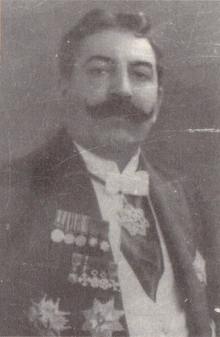|
Ali Ahmad Khan
 Amir Ali Ahmad Khan, Shaghasi (Pashto: علي احمد خان; Dari: علی احمد خان; 1883–1929) was an Afghan king from the Shaghasi family of the Barakzai tribe who was declared king of Afghanistan twice in 1929.[2] He was first declared amir of Afghanistan by an influential cleric, Naqib Sahib on 20 January 1929, in eastern Afghanistan, but was defeated by Kalakani at Jagdalak on 19 February 1929.[3] He was also declared as the amir of Afghanistan for the second time on 23 June 1929 in Kandahar, Afghanistan, by another highly influential Mufti Abd. Wasi Kandahari, but was defeated and captured by Kalakani on 3 July 1929.[2] Born in 1883 in Mashhad, Iran, the son of Loinab Khushdil Khan, and grand son of Loinab Shirdil Khan Shaghasi, Ali Ahmad Khan was educated in Murree (British India) and served as chamberlain Isk Aqasi (Shaghasi), of Amir Habibullah Khan.[4] Ali Ahmad Shaghasi played a leading role in negotiating the controversial Anglo-Afghan Treaty of 1919 during the reign of his brother-in-law Amanullah Khan, which ended the Third Anglo-Afghan War and gained Afghanistan its independence. Ali Ahmad Khan Shaghasi later rallied the Khogyani and Shinwari to quell the Khost rebellion, to which he was honoured with the honorary tile of Taj-i-Afghan by king Amanullah.[3] Sometime Minister for Home Affairs 1919-1920 and Governor of Kabul 1925-1929, Ali Ahmad also served as high commissioner of the Eastern and Southern provinces.[3] During the Afghan civil war of 1928–29, Ali was ordered to quell a Shinwari revolt, which he duly ended in December 1928.[5] Later, after Inayatullah Khan was forced to surrendered control of Kabul and Arg to Habibullāh Kalakāni on 18 January 1929, Ali was declared as a lawful Amir of Afghanistan by Naqib Sahib in Jalalabad.[6] However, Ali's reign would prove short-lived: Malik Qays of the Khugyani tribe, who had initially allied himself with Ali, brought Ali to Kalakani in exchange for 17,000 rupees and the rank of lieutenant general,[6] ending Ali's reign on 9 February. Ali later managed to make his way to Amanullah Khan in Kandahar to assist the former king's forces against Kalakani, but was defeated and captured and sent to Kabul along with Abd al-Shakur Khan (The Chief of Justice), Sad al-Din Khan (Abd al-Shakur Khan's son), and Mufti Abd al-Wasi[7] where he remained imprisoned in Kabul for over a month. Ali Ahmad defiantly kissed the cannon by which he was executed on 11 July 1929.[8][9] Other historical Afghan literature mention when Kalakani ordered his back to be tied to a cannon for his execution, Ali Ahmad turned around and instead hugged the cannon face on in defiance then called for it to be fired. Ancestry
Amir Ali Ahmad Khan Shaghasi was son of General H.E. Loinab Khushdil Khan, sometime Governor of Kabul and Kandahar, by his wife Sahira Begum, daughter of H.H. Amir al-Mumenin, Amir al-Kabir, Amir Dost Muhammad Khan, Amir of Afghanistan, by his wife, a daughter of Agha Muhammad Qizilbash. Ali Ahmad's sister, the Ulya Mukhadara Zarin Jan Begum was the mother of Humaira Begum who was the Queen consort of Afghanistan. Amir Ali Ahmad Khan's grand father, Loinab Shir Dil Khan Shaghasi was a regional Sardar from the reign of Amir Dost Muhammad Khan, especially during 1863 - 1866 and 1868 - 1879, the reign of H.H. Amir al-Mumenin, Amir Sher 'Ali Khan, Amir of Afghanistan, and was related to the Shaghasi royal family of the Barakzai dynasty. References
|
||||||||||||||||||||||||||||||||||||||||||||||||||||||||||||||||||||||||||||||||||||||||||||||||||||||||||||||||||||||||||||||||||||||||||||||||||||||||||||||||||||||||||||||||||||||||||||||||||||||||||||||||||||||||||||||||||||||||||||||||||||||||||||||||||||||||||||||||||||||||||||||||||||||||||||||||||||||||||||||||||||||||||||||||||||||||||||||||||||||||||||||||||||||||||||||||||||||||||||||||||||||||||||||||||||||||||||||||||||||||||||||||||||||||||||||||||||||||||||||||||||||||||||||||||||||||||||||||||||||||||||
Portal di Ensiklopedia Dunia
